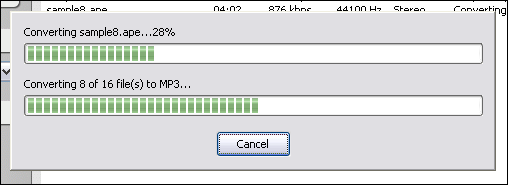M2T to AMRConvert M2T to AMR, M2T to AMR Converter |
 |
| Home | Getting Started | Download | Buy Now! | Screen Shots | FAQ | Support | Contact |
Total Audio MP3 Converter converts M2T files to AMR format. The software is an all in one audio converter that supports more than 90 audio and video files as input, and converts to popular formats such as MP3, WAV, AAC, M4A, OGG, WMA, and AMR. Total Audio MP3 Converter also supports batch conversion, and is full compatible with Vista and Windows 7.
 Click "Add Files" to choose M2T files and then add them to conversion list.  Choose one or more M2T files you want to convert and then click Open.   Click button "Convert" to convert M2T files to AMR format.  The software is converting M2T files to AMR format.  When conversion completes, you could right-click converted AMR file and choose "Play Destination" to play the outputted AMR file; or choose "Browse Destination Folder" to open Windows Explorer to browse the AMR file. What is M2T? Conceived as an affordable high definition format for digital camcorders, HDV quickly caught on with many amateur and professional videographers due to its low cost, portability and image quality acceptable for many professional productions. HDV video and audio are encoded in digital form, using lossy compression. Video is encoded with the MPEG-2 codec at a rate of either 19 or 25 Mbit/s (depending on the frame-size), using 8-bit chroma and luma samples with 4:2:0 chroma subsampling. Stereo audio is encoded with the MPEG-1 Layer 2 codec, at 384 kbit/s. The compressed audio and video are multiplexed into a MPEG transport stream, which is typically captured onto magnetic tape, but which can also be stored in a computer file. Because the primary recording media ¡ª tape ¡ª is transported with constant linear speed, the rate control for both the audio and video compression are locked to a constant bitrate. At the bitrates and frame-sizes (1280x720, 1440x1080) at which HDV operates, the video compression may introduce visible artifacts artifacts, such as blockiness, blurring, ringing. Artifacts are most visible in playback of scenes with lots of fine detail, rapid movement or other complex activity like flashing lights. These scenes would demand the bitrate to exceed the fixed 25Mbit/sec that HDV allocates for the video bitstream, and hence, suffer visible degradation. In contrast to the video, HDV audio bitrate is comparatively generous. At the coded bitrate of 384kbit/s, MPEG-1 Layer 2 audio is regarded as perceptually lossless. What is AMR? Key Features:
Convert M2T to AMR Related Topics: 3GPP to AMR, MTS to AMR, ROQ to AMR, 3GP to AMR, MOV to AMR, W64 to AMR, PSX to AMR, NUV to AMR, NUT to AMR, DIVX to AMR, PVA to AMR, VOC to AMR, M2T to AMR, WM to AMR, MTV to AMR, M4R to AMR, TS to AMR, DAT to AMR, FLIC to AMR, M2TS to AMR, OMA to AMR, ULAW to AMR, DIF to AMR, MPEG to AMR, VFW to AMR, DRC to AMR, MXF to AMR, EAC3 to AMR, SOL to AMR, DVD to AMR, FLV to AMR, F4V to AMR, CAF to AMR, RPL to AMR, DV to AMR, HDTV to AMR, MPA to AMR, THD to AMR, M2A to AMR, M1V to AMR
|
| Home | Getting Started | Download | Buy Now! | Screen Shots | FAQ | Support | Contact | Links |
| Copyright © 2008-2017 Hoo Technologies All rights reserved. Privacy Policy |